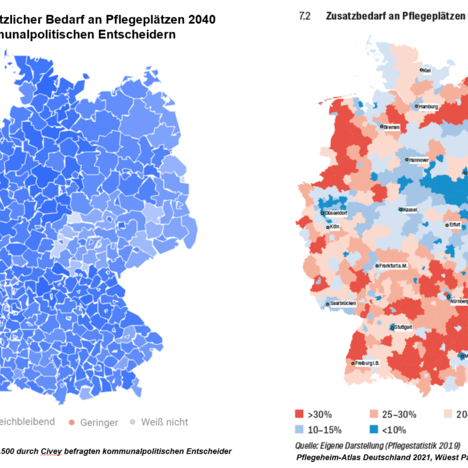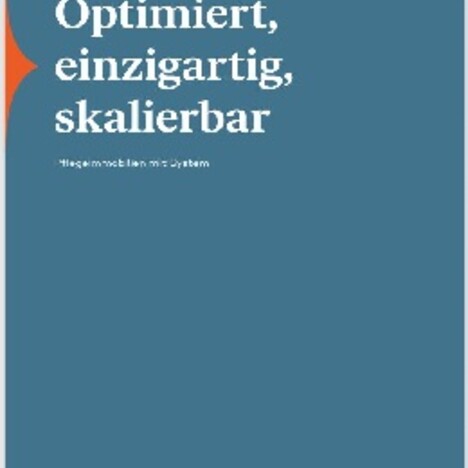12.05.2023
Cureus survey: Municipal decision-makers expect a clear increase in the number of care places needed, but see solution in assisted living
- 91% of respondents see a clearly higher or at least increased need for care places for their district by 2040
- Only 31% of the respondents see the need most likely in inpatient care – although a glaring shortage is already emerging here – assisted living is preferred – this harbours potential dangers
Hamburg, 12 May 2023. 65 percent of municipal decision-makers expect a clearly higher demand for care places in their district or independent city by 2040 compared to 2022. Another 26 percent see at least a somewhat higher need. These are the results of a representative survey conducted by the opinion research institute Civey, for which around 1,500 local political decision-makers in Germany were questioned.
"The survey shows that the impending shortage of care places in Germany is already clearly recognised in most municipalities," says Gerald Klinck, CEO of Cureus, which commissioned the survey. This also corresponds to the results of a study by Wüest Partner AG published at the beginning of 2022, which identified an increased need for care places in almost all districts by 2040. According to this study, the demand in about half of all districts alone will be at least 20 percent higher than today's level.
Dangerous fallacy: Municipal decision-makers see assisted living as the solution
When asked about the segment in which they are most likely to see a greater need for the creation of care capacities, only 31 percent of the respondents named inpatient care. Significantly more, namely 43 percent, named assisted living. Only 19 percent mentioned day care. The differences between the federal states are small. The greatest perception of a higher need for inpatient care is among municipal decision-makers from Bavaria (35.1%), the lowest among those from Mecklenburg-Western Pomerania (22.6%).
"Unfortunately, most municipal decision-makers seem to want to rely more on assisted living as a solution. This preference for care in one's own home is quite understandable from a human point of view, but: inpatient care is not a question of choice – for those who depend on it, assisted living is unfortunately no longer an alternative," Klinck warns. Due to demographic change, the need for inpatient care will continue to increase. In addition to the study by Wüest Partner, this is also shown by the German nursing care forecast 2023 as well as a study conducted by the analysis company bulwiengesa, which specialises in the real estate industry, at the end of 2021. They show that, in mathematical terms, around 600,000 new inpatient care places will have to be built in Germany by 2040. Moreover, the occupancy rate of the available places in full inpatient care was already aproxx. 90 percent in 2021. In addition, the existing capacities are by no means secure. This is because 29 percent of the 15,400 nursing homes in Germany (data as of 2019) were already more than 40 years old in 2021 and a considerable number of them no longer meet the legal requirements or construction standards.
Klinck suspects that another possible reason for the preference of municipal decision-makers for assisted living is the current housing construction goal of the federal government. 400,000 new flats are to be created in Germany every year according to the politicians' ideas. "Assisted living is statistically classified as housing construction. Municipalities may therefore hope to score points with appropriate housing both in terms of creating new living space and in terms of the care issue. But this is a dangerous fallacy," says Klinck, "because today's baby boomer generation will hit our care system with full force. In 2040, there will be many more very old people than today. And statistically speaking, the need for care will increase disproportionately for people aged 80 and over. In addition, in times of scarce personnel and the singularisation of households, care is probably better bundled in one location and provided in company with a colourful daily programme than sending valuable care skills on an outpatient basis in a small car through traffic jams."
Klinck demands: "For these reasons, municipal decision-makers must do more to promote the construction of care homes." This is possible through the provision of municipal land, market-based investment cost rates for operators and by influencing state policy. The latter could, for example, provide local funding institutions with special programmes and ensure the long-term reliability of the regulatory framework. Federal policy should also be addressed in order to ensure an adequate volume of local funding, for example from the KfW, and reliable access to it in the long term, without ever increasing the technical demands on building owners. All political levels must take measures to advance the construction of care homes as part of the social infrastructure of the future and to prevent the impending care catastrophe. This is the only way to attract more investors to this important market segment.
Lower demand in many regions of eastern Germany
In eastern Germany, especially in Saxony and Thuringia, fewer of those surveyed by Civey see a need for new care places than elsewhere in Germany. This is in line with Wüest Partner's forecast. This shows that in many places in Saxony, Thuringia, Saxony-Anhalt and parts of Brandenburg, the need for new care places is lower than elsewhere in Germany. But even in these regions, with few exceptions, there will be a higher demand for care places in 2040 than today in most districts. Along the North Sea coast, in parts of Hesse, Lower Saxony and North Rhine-Westphalia, the additional need for new care places is also less pronounced than elsewhere in Germany, according to Wüest Partner. Here, however, there is no discernibly lower perception of higher demand on the part of those surveyed by Civey in comparison.





